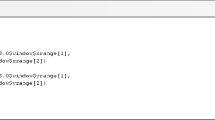Abstract
Multi-dimensional Markov chain conditional simulation (or interpolation) models have potential for predicting and simulating categorical variables more accurately from sample data because they can incorporate interclass relationships. This paper introduces a Markov chain random field (MCRF) theory for building one to multi-dimensional Markov chain models for conditional simulation (or interpolation). A MCRF is defined as a single spatial Markov chain that moves (or jumps) in a space, with its conditional probability distribution at each location entirely depending on its nearest known neighbors in different directions. A general solution for conditional probability distribution of a random variable in a MCRF is derived explicitly based on the Bayes’ theorem and conditional independence assumption. One to multi-dimensional Markov chain models for prediction and conditional simulation of categorical variables can be drawn from the general solution and MCRF-based multi-dimensional Markov chain models are nonlinear.
Similar content being viewed by others
References
Besag, J., 1974, Spatial interaction and the statistical analysis of lattice systems (with discussion): J. Roy. Stat. Soc. Ser. B, v. 36, no. 2, p. 192–236.
Besag, J., 1986, On the statistical analysis of dirty pictures (with discussions): J. Roy. Stat. Soc. Ser. B, v. 48, no. 3, p. 259–302.
Elfeki, A.M., Dekking, F.M., 2001, A Markov chain model for subsurface characterization: Theory and applications: Math. Geol., v. 33, no. 5, p. 569–589.
Derin, H., Elliott, H., Cristi, R., Geman, D., 1984, Bayes smoothing algorithms for segmentation of binary images modeled by Markov random fields: IEEE Trans. Pattern Anal. Mach. Intell., v. 6, no. 6, p. 707–720.
Fjortoft, R., Delignon, Y., Pieczynski, W., Sigelle, M., Tupin, F., 2003, Unsupervised classification of radar images using hidden Markov chains and hidden Markov random fields: IEEE Trans. Geosci. Remote Sens., v. 41, no. 3, p. 675–686.
Friedman, N., Geiger, D., Goldszmidt, M., 1997, Bayesian network classifiers: Mach. Learn., v. 29, no. 2-3, p. 131–163.
Gray, A.J., Kay, I.W., Titterington, D.M., 1994, An empirical study of the simulation of various models used for images: IEEE Trans. Pattern Anal. Mach. Intell., v. 16, no. 5, p. 507–513.
Haslett, J., 1985, Maximum likelihood discriminant analysis on the plane using a Markovian model of spatial context: Pattern Recognit., v. 18, no. 3-4, p. 287–296.
Idier, J., Goussard, Y., Ridolfi, A., 2001, Unsupervised image segmentation using a telegraph parameterization of Pickard random fields, in Moore, M., ed., Spatial Statistics. Methodological Aspects and Some Applications, Lecture Notes in Statistics, vol. 159: Springer, New York, p. 115–140.
Journel, A.G., 2002, Combining knowledge from diverse sources: an alternative to traditional data independence hypothesis: Math. Geol., v. 34, no. 5, p. 573–596.
Li, W., 2006, Transiogram: a spatial relationship measure for categorical data: Int. J. Geogr. Inf. Sci., v. 20, no. 6, p. 693–699.
Li, W., Zhang, C., 2005, Application of transiograms to Markov chain simulation and spatial uncertainty assessment of land-cover classes: GISci. Remote Sens., v. 42, no. 4, p. 297–319.
Li, W., Zhang, C., Burt, J.E., Zhu, A.X., 2005, A Markov chain-based probability vector approach for modeling spatial uncertainty of soil classes: Soil Sci. Soc. Am. J., v. 69, no. 6, p. 1931–1942.
Li, W., Zhang, C., Burt, J.E., Zhu, A.X., Feyen, J., 2004, Two-dimensional Markov chain simulation of soil type spatial distribution: Soil Sci. Soc. Am. J., v. 68, no. 5, p. 1479–1490.
Lin, C., Harbaugh, J.W., 1984, Graphic display of two- and three-dimensional Markov computer models in geology: Van Nostrand Reinhold Company, New York, p. 180.
Martin, R.J., 1996, Some results on unilateral ARMA lattice processes: J. Stat. Plan. Infer., v. 50, no. 3, p. 395–411.
Martin, R.J., 1997, A three dimensional unilateral autoregressive lattice process: J. Stat. Plan. Infer., v. 59, no. 1, p. 1–18.
Ortiz, J.M., Deutsch, C.V., 2004, Indicator simulation accounting for multiple-point statistics: Math. Geol., v. 36, no. 5, p. 545–565.
Pickard, D.K., 1980, Unilateral Markov fields: Adv. Appl. Probab., v. 12, no. 3, p. 655–671.
Qian, W., Titterington, D.M., 1991, Multidimensional Markov chain models for image textures: J. Roy. Stat. Soc. Ser. B, v. 53, no. 3, p. 661–674.
Ramoni, M., Sebastiani, P., 2001, Robust Bayes classifiers: Artif. Intell., v. 125, no. 1-2, p. 209–226.
Rosholm, A., 1997, Statistical methods for segmentation and classification of images: PhD dissertation, Technical University of Denmark, Lyngby, p. 187.
Ripley, B.D., 1990, Gibbsian interaction models, in Griffith, D.A., ed., Spatial statistics: Past, present, and future: Institute of Mathematical Geography, Syracuse University, p. 3–25.
Sharp, W.E., Turner, B.F., 1999, The extension of a unilateral first-order autoregressive process from a square net to an isometric lattice using the herringbone method, in Lippard, S.J., Nass, A., Sinding-Larsen, R., eds., Proceedings of IMAG’99, 6–11 August 1999, Trondheim, p. 255–259.
Turner, B.F., Sharp, W.E., 1994, Unilateral ARMA processes on a square net by the herringbone method: Math. Geol., v. 26, no. 5, p. 557–564.
Zhang, C., Li, W., 2005, Markov chain modeling of multinomial land-cover classes: GISci. Remote Sens., v. 42, no. 1, p. 1–18.
Author information
Authors and Affiliations
Corresponding author
Rights and permissions
About this article
Cite this article
Li, W. Markov Chain Random Fields for Estimation of Categorical Variables. Math Geol 39, 321–335 (2007). https://doi.org/10.1007/s11004-007-9081-0
Received:
Accepted:
Published:
Issue Date:
DOI: https://doi.org/10.1007/s11004-007-9081-0




